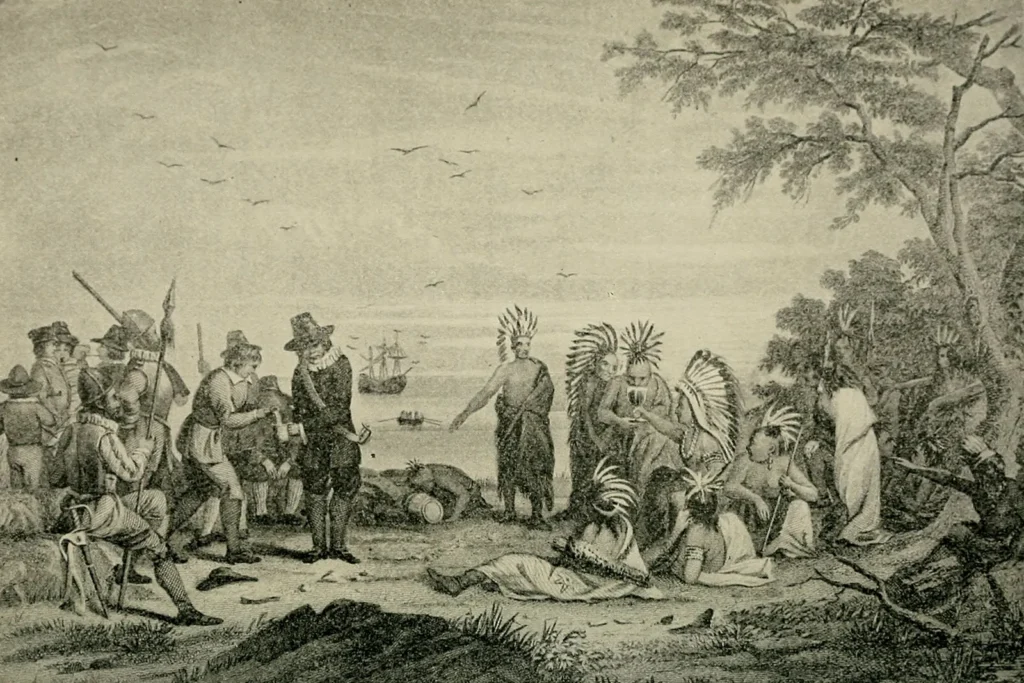New England, located in the northeastern United States, is a region steeped in history and culture. Its story begins long before the arrival of European settlers, with indigenous peoples shaping the land and laying the foundations for what would become a cradle of American history. New England’s historical significance is undeniable, and its past is as diverse as its picturesque landscapes. From the rocky coastlines of Maine to the rolling hills of Vermont, this region has been witness to profound historical events and transformations.

✅ AI Essay Writer ✅ AI Detector ✅ Plagchecker ✅ Paraphraser
✅ Summarizer ✅ Citation Generator
Early Indigenous Inhabitants
Before the arrival of European settlers, New England was inhabited by various indigenous groups, each with its own distinct cultures, languages, and lifestyles. The Wampanoag people, for instance, were coastal inhabitants who excelled in fishing and agriculture. They cultivated crops like corn, beans, and squash, a combination known as the “Three Sisters,” which sustained their communities. The Wampanoag were skilled in constructing wetus (dome-shaped homes) and wampum, intricate beadwork used for trade and communication. Their rich cultural heritage is still celebrated today, especially during Thanksgiving, as they played a significant role in the survival of early European settlers.

The Pequot and Mohegan tribes, on the other hand, were involved in extensive trade networks, facilitating the exchange of goods and ideas across the region. The Pequot, in particular, were known for their beadwork and craftsmanship. However, tensions between these tribes and European colonists would eventually lead to conflicts such as the Pequot War.
The Abenaki people, residing in present-day Maine and parts of New Hampshire and Vermont, had a deep spiritual connection to the land and were skilled hunters, gatherers, and farmers. They lived in wigwams and had a rich oral tradition, passing down their history and cultural knowledge through storytelling and songs.
The Arrival of European Settlers
The arrival of European settlers in New England was marked by complex interactions and, at times, controversial actions. While some settlers sought religious freedom and economic opportunities, their presence had far-reaching consequences. The clash of cultures and interests between Europeans and indigenous communities often resulted in tensions and conflicts.
One of the most infamous incidents was the “First Thanksgiving,” where European settlers, including the Pilgrims, celebrated a successful harvest with the Wampanoag people. However, the history of European colonization also includes episodes of land dispossession, violence, and the spread of diseases that devastated indigenous populations.
As settlers expanded their colonies, disputes over territory and resources escalated. Conflicts like the Pequot War and King Philip’s War led to the loss of indigenous lives and lands. These controversial actions remain a significant part of New England’s history, reminding us of the complex and often tragic consequences of European colonization on indigenous communities.

The formation of the New England colonies in the 17th century marked a pivotal chapter in the region’s history. Massachusetts, Connecticut, Rhode Island, New Hampshire, and Maine were established, each with its unique motivations for colonization. Massachusetts became a beacon for educated clergy seeking to create a model Christian society. The Mayflower Compact, signed in 1620, set a precedent for self-governing communities. Early governance systems took root, and the colonies developed distinct identities. As these colonies grew and evolved, they laid the foundation for the future United States.
New England’s Role in the American Revolution
New England played a central role in the lead-up to the American Revolution. The region became a crucible of revolutionary ideals, with influential figures like Samuel Adams and John Adams advocating for independence from British rule. The Boston Tea Party and the Boston Massacre were pivotal events that further stoked tensions. When the Battles of Lexington and Concord erupted in 1775, New Englanders showed their commitment to the cause of liberty, solidifying the region’s place at the forefront of the fight for American independence. These events not only shaped the destiny of New England but also the entire nation.
Battles and Conflicts
The Revolutionary War in New England was characterized by significant battles and conflicts. The Battles of Lexington and Concord, fought in April 1775, marked the start of the war.
Battles of Lexington and Concord (April 1775): These battles are often considered the spark that ignited the American Revolution. British troops were dispatched to seize colonial weapons and supplies, but they encountered resistance from Minute Men and militia units. The first shot, known as the “shot heard ’round the world,” rang out in Lexington. Though it was a relatively small engagement, it had significant symbolic importance, marking the beginning of the war for American independence.

Battle of Bunker Hill (June 1775): Fought on the Charlestown Peninsula near Boston, this battle was one of the early and bloodiest clashes of the Revolutionary War. American forces, lacking sufficient ammunition, were ordered not to fire until they saw the whites of the British troops’ eyes. The battle ended in British victory, but it demonstrated the colonists’ determination and their ability to stand their ground against a superior force. The battle is famous for the quote, “Don’t fire until you see the whites of their eyes,” attributed to American officer William Prescott. It was a pivotal moment that showed the American resolve to fight for independence.

Industrialization and Immigration
The 19th century brought about transformative changes in New England, primarily driven by industrialization. The region became a hub for manufacturing, with textile mills and factories dotting the landscape. The Lowell System, a groundbreaking labor model, revolutionized the textile industry, attracting a workforce that would help propel New England into an industrial powerhouse.
Simultaneously, waves of immigration flowed into New England, bringing with them diverse cultures, traditions, and languages. Irish immigrants escaping the Great Famine, Italian immigrants seeking economic opportunities, and Eastern European immigrants looking for a better life all contributed to the region’s cultural mosaic. These newcomers played a crucial role in the industrial workforce and enriched New England’s social fabric, leaving a lasting imprint on its identity.
New England in the Modern Era
The 20th century marked a transformative period for New England, reshaping its urban landscape and solidifying its reputation as a hub of intellectual and cultural excellence. Urbanization led to the growth of cities, positioning them as centers of industry and innovation. Boston, in particular, stood out with its world-renowned universities and research institutions, notably Harvard University and MIT, which attracted some of the brightest minds globally, fostering innovation and scientific progress.

In the realm of arts and culture, New England’s cultural institutions thrived. The Boston Symphony Orchestra, among others, added to the region’s cultural vibrancy. As technology continued to advance, New England became a focal point for innovation, particularly in fields like biotechnology and information technology. These advancements not only contributed to the region’s economic vitality but also reinforced its status as a leader in cutting-edge research and cultural expression, leaving an indelible mark on the modern era.
7 Interesting Facts about New England
- New Hampshire, known as the “Granite State,” earned its nickname due to its rugged terrain and abundant granite quarries. The stone was essential for numerous iconic structures, including the Bunker Hill Monument.
- Vermont, famous for its picturesque landscapes, is the leading producer of maple syrup in the United States. The state’s sugarhouses produce this sweet elixir, especially during the sugaring season in late winter and early spring.
- Rhode Island, the smallest state in the U.S., played a significant role in the early American industrial revolution. Slater Mill, built in Pawtucket in 1793, was the birthplace of the American Industrial Revolution.
- Captain John Smith, renowned for his role in the founding of Jamestown, Virginia, also explored and mapped the New England coast in the early 17th century. His explorations laid the groundwork for subsequent settlements in the region.
- New England’s early settlers included educated clergy who played a central role in shaping the region’s culture and leadership. These religious leaders contributed to the development of educational institutions and the promotion of literacy.
- The Mayflower Compact, signed in 1620 by Pilgrims aboard the Mayflower, was an early example of democratic self-governance in the New World. It established a commitment to self-rule and cooperation among the colonists.
- New England’s fall foliage is celebrated worldwide for its breathtaking autumn colors. The region’s forests burst into brilliant shades of red, orange, and yellow during the fall, attracting visitors from around the globe.
Conclusion
New England’s history is a tapestry woven with the threads of indigenous cultures, European colonization, revolutionary fervor, industrialization, immigration, and intellectual achievement. It is a region that has left an indelible mark on American history and continues to thrive as a place where the past and present intersect, creating a dynamic and culturally rich tapestry that embodies the spirit of the United States. From its early beginnings to its modern achievements, New England remains a testament to the enduring spirit of innovation, diversity, and resilience.
FAQ
Follow us on Reddit for more insights and updates.





Comments (0)
Welcome to A*Help comments!
We’re all about debate and discussion at A*Help.
We value the diverse opinions of users, so you may find points of view that you don’t agree with. And that’s cool. However, there are certain things we’re not OK with: attempts to manipulate our data in any way, for example, or the posting of discriminative, offensive, hateful, or disparaging material.